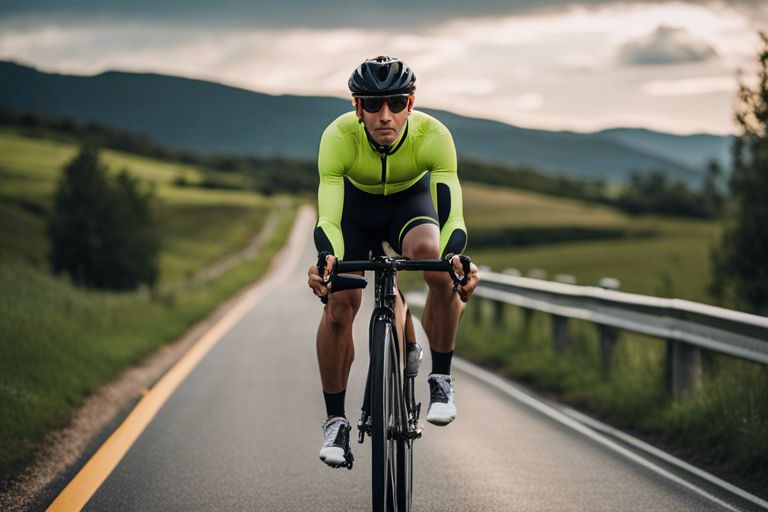With their sleek design and specialized features, cycling shoes play a crucial role in maximizing performance and efficiency for cyclists of all levels. These shoes are uniquely crafted to enhance power transfer, stability, and comfort during rides, ultimately improving the overall cycling experience. Understanding the mechanics behind how cycling shoes work can help cyclists choose the right pair for their needs and elevate their performance on the road or trail.
Key Takeaways:
- Cycling shoes are designed to provide a secure and efficient connection between the cyclist’s feet and the pedals.
- Features such as stiff soles, snug fit, and cleat compatibility help improve power transfer and pedal efficiency.
- Cycling shoes come in a variety of styles for different types of cycling, including road biking, mountain biking, and indoor cycling.

Understanding Cycling Shoes
Definition and Purpose of Cycling Shoes
With the rise in popularity of cycling as a recreational activity and sport, the demand for specialized footwear has also increased. Cycling shoes are specifically designed to enhance performance, comfort, and safety while riding a bike. These shoes are equipped with features that make them uniquely suited for the rigors of cycling, such as stiff soles for efficient power transfer, secure closures for a snug fit, and ventilation to keep the feet cool.
The Evolution of Cycling Shoes
For decades, cycling shoes have undergone significant advancements in terms of design, materials, and technology. From the early days of simple leather straps and metal cleats to the modern era of carbon soles and BOA dial closures, cycling shoes have come a long way in meeting the needs of cyclists. The evolution of cycling shoes has been driven by the pursuit of improved performance, comfort, and style, resulting in a wide range of options to cater to different types of riding disciplines and preferences.
Key Features of Cycling Shoes
Clearly, cycling shoes are an important piece of equipment for any serious cyclist. These specialized shoes offer several key features that make them ideal for enhancing performance and comfort while riding. Some of the main features of cycling shoes include:
- Stiff Soles: Cycling shoes have stiff soles that provide better power transfer from your legs to the pedals.
- Retention System: Most cycling shoes come with a retention system such as straps, laces, or dial closures to securely hold your feet in place.
- Ventilation: Many cycling shoes have breathable mesh panels or perforations to ensure proper airflow and keep your feet cool and dry.
- Compatibility: Cycling shoes are designed to be compatible with a variety of pedal systems such as SPD, Look Keo, or Speedplay.
- Lightweight Construction: Cycling shoes are lightweight to reduce overall weight and increase pedaling efficiency.
Any serious cyclist should consider these key features when choosing the right cycling shoes for their riding style and preferences.
Types of Cycling Shoes
- Road Cycling Shoes: These are designed for road cycling and feature a stiff sole for maximum power transfer.
- Mountain Biking Shoes: These have more aggressive tread patterns for better grip and are typically more durable to withstand off-road conditions.
- Indoor Cycling Shoes: These are designed specifically for use in indoor cycling classes and feature breathable materials for comfort during intense workouts.
- Triathlon Shoes: These are designed for quick transitions and often feature easy-to-adjust straps and drainage holes for wet conditions.
- Commuter Shoes: These are more casual-looking cycling shoes designed for urban commuting with features like reflective elements for visibility.
Assume that there is a perfect type of cycling shoe for every kind of cyclist, depending on their specific needs and riding style.
Essential Components
Cycling shoes are specially designed footwear that provide the necessary interface between the rider’s feet and the pedals. The important components of cycling shoes include the sole, closure system, upper material, and cleat compatibility. Each of these components plays a crucial role in optimizing performance and comfort for the cyclist.
Types of closures can vary from traditional laces to modern BOA dials, ensuring a secure fit and efficient power transfer to the pedals. The upper material of cycling shoes can range from synthetic leather to breathable mesh, providing support, comfort, and ventilation during long rides.
Benefits of Using Cycling Shoes
Power Transfer Efficiency
An crucial benefit of using cycling shoes is their ability to enhance power transfer efficiency. The stiff soles of cycling shoes eliminate energy loss that occurs with flexible soles found in regular shoes. This ensures that more power from your legs is directly transferred to the pedals, resulting in improved speed and performance.
Improved Pedaling Technique
Benefits of Using Cycling Shoes
With cycling shoes, cyclists can achieve a more efficient and powerful pedaling technique. The rigid sole of the shoe helps in distributing pressure evenly across the foot, promoting a smoother pedal stroke. This leads to reduced strain on the foot and ankle, allowing riders to pedal longer and with greater ease.
Enhancing Comfort and Stability
Shoes
Cycling shoes are designed to provide optimal comfort and stability during rides. The snug fit and secure fastening systems of cycling shoes keep the foot in the correct position, reducing the risk of discomfort or injury. Additionally, the stiff sole minimizes foot fatigue and improves overall stability on the bike, especially during high-intensity rides or when navigating challenging terrain.

Choosing the Right Cycling Shoes
For Fit and Sizing
When choosing the right cycling shoes, fit and sizing are crucial factors to consider. Properly sized shoes can prevent discomfort and injuries while riding. It is important to try on different brands and styles to find the best fit for your foot shape and size. Make sure there is no pinching or pressure points, and that your heel is snugly held in place without slipping.
For Compatibility with Pedals
One important aspect to consider when selecting cycling shoes is their compatibility with your pedals. Different types of cycling – such as road cycling, mountain biking, or indoor cycling – may require specific pedal systems. Look for shoes that are compatible with your pedals to ensure efficient power transfer and a secure connection while riding.
It is important to note that some pedals require specific cleats that attach to the shoe. For example, road cycling shoes typically require a three-bolt cleat attachment, while mountain biking shoes may use a two-bolt cleat. Make sure your shoes and pedals are compatible to avoid any issues while cycling.
For Considerations for Different Cycling Disciplines
Disciplines such as road cycling, mountain biking, triathlon, and indoor cycling have specific shoe requirements tailored to the demands of each sport. Road cycling shoes are designed for maximum power transfer and aerodynamics, with stiff soles and lightweight materials. Mountain biking shoes offer more traction and durability for off-road terrain. Triathlon shoes are quick to put on and often feature drainage holes for water. Indoor cycling shoes have breathable materials and recessed cleats for easy walking.

Maintenance and Care for Cycling Shoes
Cleaning and Storage
Many cyclists overlook the importance of proper maintenance and care for their cycling shoes. To ensure the longevity and performance of your shoes, it is crucial to clean them regularly and store them properly.
When to Replace Cycling Shoes
Cleaning your cycling shoes after each ride is imperative, but there comes a time when cleaning and maintenance are not enough. Knowing when to replace your cycling shoes is important for both your comfort and safety on the bike.
Tips for Longevity and Performance
- Regularly clean your cycling shoes with mild soap and water.
- Avoid storing your shoes in damp or humid conditions.
- Inspect your shoes for any signs of wear and tear, such as sole delamination or worn-out closures.
Performance is key when it comes to cycling shoes. Ensuring that your shoes are well-maintained and cared for will not only extend their lifespan but also enhance your riding experience. Knowing how to properly care for your cycling shoes can make a significant difference in their performance and durability.
Conclusion
Presently, cycling shoes play a crucial role in enhancing the performance and comfort of cyclists. By providing a stiff sole for efficient power transfer, a secure closure system for stability, and compatibility with clipless pedals for a seamless ride, cycling shoes offer numerous benefits to riders of all levels. Understanding how cycling shoes work can help cyclists make informed decisions when choosing the right pair for their needs, ultimately leading to a more enjoyable and productive cycling experience.
FAQ
Q: How do cycling shoes help with performance?
A: Cycling shoes are designed with stiff soles that efficiently transfer power from your legs to the pedals. This direct power transfer enables you to pedal more effectively, resulting in improved performance and efficiency while cycling.
Q: What are the key features of cycling shoes?
A: Cycling shoes typically have a snug fit to prevent your feet from moving around inside the shoe, which helps in maintaining stability and control. They also come with specialized cleats on the sole that attach to the pedals, allowing you to pedal more efficiently. Additionally, most cycling shoes have ventilation to keep your feet cool and comfortable during long rides.
Q: How should I choose the right cycling shoes?
A: When selecting cycling shoes, consider factors such as fit, type of riding you do, and budget. Ensure the shoes are snug but not too tight, and that they are compatible with your pedal system. Road cycling shoes are designed for speed and efficiency, while mountain biking shoes offer more traction for off-road conditions. It’s necessary to try on different styles and brands to find the best fit for your feet and riding style.




